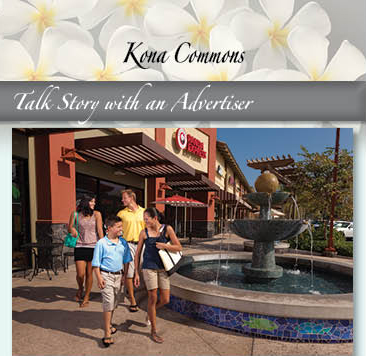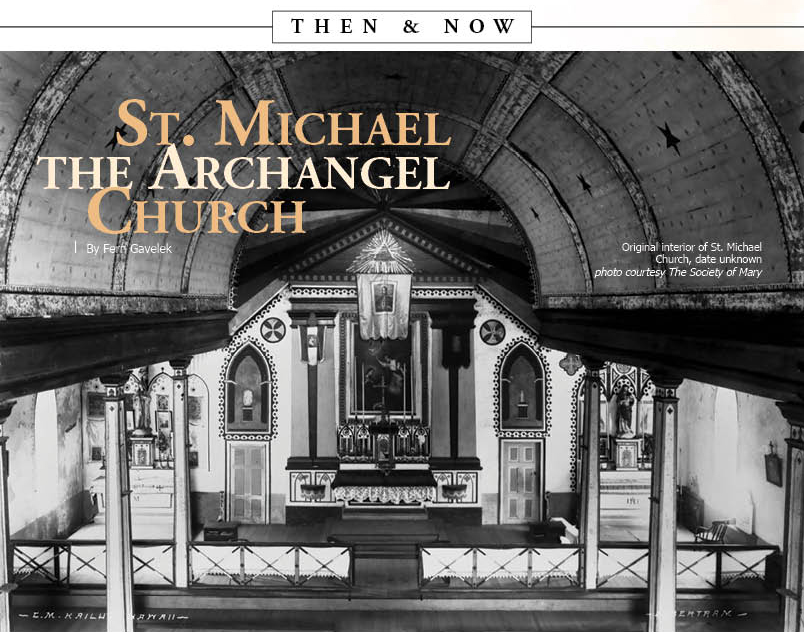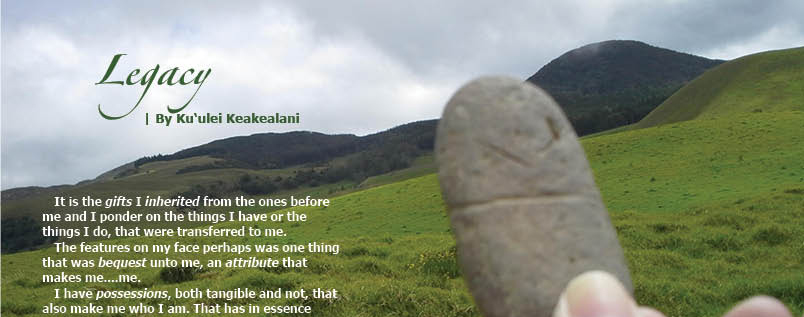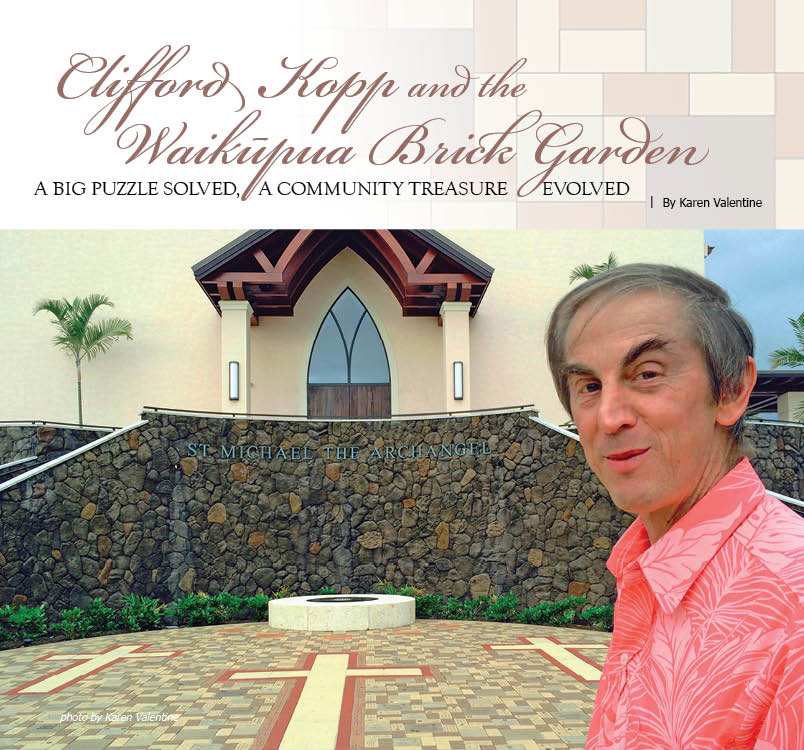
Clifford Kopp and the Waikūpua Brick Garden
 “There are no extra pieces in the universe.
“There are no extra pieces in the universe.
Everyone is here because he or she has a place to fill,
and every piece must fit itself into the big jigsaw puzzle.”
– Deepak Chopra
By Karen Valentine
It seems that Dr. Clifford Kopp has found his calling in life: to take the most difficult challenge and make all the pieces fit together. As a Kailua-Kona prosthodontist, he practices the dental specialty of fitting new teeth into difficult spaces in people’s mouths. As a community volunteer, he helps organize parades, fireworks displays, and other big projects such as the Higashihara Park playground.
As a child, Cliff loved jigsaw puzzles. As an adult, he finds the most difficult and largest jigsaw puzzles in the world and assembles them. In 2011, he completed a 32,256-piece puzzle—the world’s largest—measuring nineteen by seven feet. It took him 56 days, assembling eight sections of 4,032 pieces each.
Cliff says he gets intense and single-focused during the times he works on puzzles, often ignoring other daily tasks or issues of life. It’s a lot like the ancient Greek mathematician, puzzle maker, and inventor Archimedes, who it is said ran naked through the streets shouting, “Eureka!” after discovering the law of buoyancy in the bathtub. Forgetting he had no clothes on, he wouldn’t let anything come between him and his work. Ideas came to him at any moment, and he would scribble them on any available surface.
Ideas usually came at 3am for Cliff, he says, while contemplating his latest geometric puzzle—the beautiful and complex Waikūpua Brick Garden at the recently rebuilt St. Michael the Archangel Church in Kailua-Kona—composed of 2,500 bricks of various sizes, arranged in a 32-foot diameter circle. Just imagine the challenge of fitting so many rectangular pieces into a circle and creating a beautiful and meaningful work!
At least 1,200 of the bricks are engraved with designs—either personalized for someone who bought a brick, or scribed with quotations from the Bible, or depicting aspects of the history of the church.
The idea for a brick garden as a feature of the first Roman Catholic Church on the island, which was irreparably damaged in the October 15, 2006 earthquake, came as a means to raise funds for its reconstruction. Barbara Kossow, administrative specialist for the County of Hawai‘i and a member of St. Michael’s Church, had worked with Cliff to design and build a brick garden at the new West Hawai‘i Civic Center. Inspired by that project’s success, Barbara proposed the idea to church officials, who then invited him to help.
The local dentist and community volunteer, who is of Jewish, not Catholic, heritage, didn’t hesitate to accept the challenge. After all, it was a puzzle and a challenge, too. However, he laughs, “The Civic Center’s brick garden was elementary school level, while this one is a PhD in brick gardens!”
“My first thought after the first meeting with the church staff was, ‘You’re crazy if you try this.’ One minute later, I thought, ‘You’re even more out of your mind if you don’t do this. When would you ever get the chance to work on an iconic church that was taken down by an earthquake?’’’
There is an old well located in the center of the entrance to the new church. Below it runs an anchialine water source named Waikūpua, which runs from the top of Hualālai mountain, passes beside St. Michael’s, and enters the sea at Hulihe‘e Palace. Waikūpua in simple form means “blessed water.” The design for the new brick garden, now named Waikūpua Brick Garden, begins at the well and stretches makai (to the ocean) toward Ali‘i Drive. When people approach the church from Ali‘i Drive, they are greeted by the garden and invited to walk over it, exploring all of its messages.
The basic design proposed by Cliff features the three crosses of Calvary—a large one in the center and two smaller ones on either side. Alterations, details, and levels of complexity evolved from there.
The Rev. Konelio “Father Lio” Faletoi, pastor of St. Michael’s says, “I thought it was a great idea to do a brick garden and have it open to the whole community, not just St. Michael’s members. We put a sign out at the entrance inviting people who were interested in a brick to contact us. So what you see here are parishioners, visitors, people from all over the world. It really highlights the diversity of our community. The church has served the needs of the community since 1840 and will continue to serve the needs of the community here.”
The brick garden project began on Mother’s Day, 2014 and was completed just in time for the dedication of the new St. Michael’s on Annunciation Day, March 25.
As the design continued to percolate in Cliff’s brain, orders for bricks were coming in. People had the option of buying a small, medium, or large size brick, and to date, some 1,200 bricks have been ordered of a total of 1,600 possible engraved bricks. Additional bricks make up the spaces and other parts of the design. Cliff knew he had to fit them all together, so he calculated the ratio of the brick sizes based on the numbers of orders for each. They were being requested at a ratio of one large to two medium to nine small bricks. Then, he devised a square made up of one large, two medium, and nine small engraved bricks, with six more blank bricks. This 19-brick square would be repeated 150 times within the circle.
For a long time, Cliff was concerned about the brick grid placement being too linear.
“The radical change in the design occurred in October, when I changed the basic layout from linear to a non-linear geometry—difficult to do with bricks. The effect became that the only thing that was seen as linear were the actual crosses, and the design began to flow to the exact center of the middle cross, that of Christ. I knew immediately of its greater potential, and all of the other concepts started falling into place from there over the next couple of months.”
Throughout the project, he says, Cliff worked directly with graphic artist John Lewis, to whom he gives all credit for the individual artistry of the bricks, and also for his patience in keeping up with all adaptations to the overall design.
There are three other significant parts of the layout. One is a “lei” of larger bricks arrayed around the well. They feature drawings of the five historic churches of the parish, laid out from north to south in the order of the churchsʻ locations from Kohala to Ka‘ū, with St. Michael’s in the middle.
“As immigrants arrived in the late 1800s to work the plantations, outlying churches were built,” Cliff explains. “They became the outposts of the parish, and priests of that time would have to either walk or ride donkey to administer to the people. I wanted to illustrate that history.”
The second significant part of the design is a “glow” around the center cross, composed of 64 reddish-colored bricks engraved with the names of individuals who played important roles in the church since 1839, including pastors, associate priests, sisters and deacons, and one brick for Pope Francis.
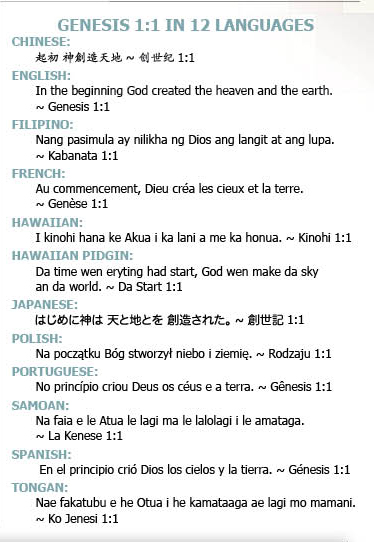 The third feature that people find intriguing is a series of 12 bricks placed in a central “column.” You can follow them as you walk from the entrance, around the cross, and toward the well. They’re called the Genesis bricks, appropriately beginning at the entrance with “In the beginning God created the heaven and the earth.” This quote from Genesis 1:1 in the Bible is repeated in 12 languages chosen mainly from the 12 most common Hawai‘i immigrant cultures. There is even one in Hawaiian Pidgin.
The third feature that people find intriguing is a series of 12 bricks placed in a central “column.” You can follow them as you walk from the entrance, around the cross, and toward the well. They’re called the Genesis bricks, appropriately beginning at the entrance with “In the beginning God created the heaven and the earth.” This quote from Genesis 1:1 in the Bible is repeated in 12 languages chosen mainly from the 12 most common Hawai‘i immigrant cultures. There is even one in Hawaiian Pidgin.
There are hundreds of stories in the bricks—too many to mention in this story. A visit to the brick garden is a wonderful experience of discovery, similar to walking through a cemetery and imagining the people whose names are on the grave markers.
As each one of the engraved bricks was delivered, Cliff laid them out in squares in his driveway, 156 of them, all numbered. He had already allocated spaces for them on a large plan for the garden, which sat upon his pool table for months, filled with colored index cards. As the church renovation neared completion, it came time for laying the bricks.
“This was not setting bricks, this was setting a puzzle,” he says. The only problem was, “It was 16 days before the dedication, and there were no masons. I was stuck. The site itself was a train wreck.”
Characteristically, he says, “You don’t fear. You accept the idea that it’s going to happen and let it evolve.” Examining some business cards on a bulletin board, he came up with the name of Aisea Tuikolovatu, a local mason whose company works on a lot of major projects. Against all odds, he was both available and willing to pitch in with bricklayers, ‘ohana and aloha.
It all shifted into high gear, and Cliff says he worked 21-hour days for seven consecutive days, during which he says he could be somewhat intense. It’s a description with which Barbara Kossow agrees.
“I served as a liaison between Cliff and St. Michael’s,” Barbara explains, “—a buffer between Cliff and others because he can be difficult to work with. It’s only because he is a perfectionist. He takes care of detail. That’s what I like about working with him.”
The bricks were laid over a period of three days just prior to the dedication. Volunteers from the church and community all came together to help, and a traditional Hawaiian blessing was performed by Kahu Danny Akaka as the first brick was laid. The Akaka family is also recognized on a brick.
The entire project was a person-to-person experience for Cliff, too. Each order that came in for a brick had to be examined for possible misspellings and to have some of the details confirmed with the person ordering it. He would often call or email the individual, talking about the words and the possible artwork to be added to it.
“I talk story with a lot of people,” says Cliff. “We were setting the lights up on Good Friday morning. A small woman was there peering over the bricks. She looked about 88 years of age. She said, ‘I’m looking for my husband.’ I said, ‘What is your husband’s name?’ ‘Henry,’ she said. ‘And his last name?’ ‘Kekai.’ ‘Was there any artwork on it?’ ‘A dove,’ she said. We walked around, and out of 1,000 bricks there at the time, we both found it. She took her little wooden cane and went tap, tap, tap. I said to myself, ‘That’s why we built the garden.’” ❖
For information on ordering a brick, contact St. Michael the Archangel Church, 808.326.7771. Orders will close sometime this fall.
Waikūpua Brick Garden and the church are located at 75-5769 Ali‘i Dr., Kailua-Kona.
Contact Dr. Clifford Kopp
